广州小学英语口语第二册 Unit 4 What Do You See 教案
文档属性
| 名称 | 广州小学英语口语第二册 Unit 4 What Do You See 教案 |
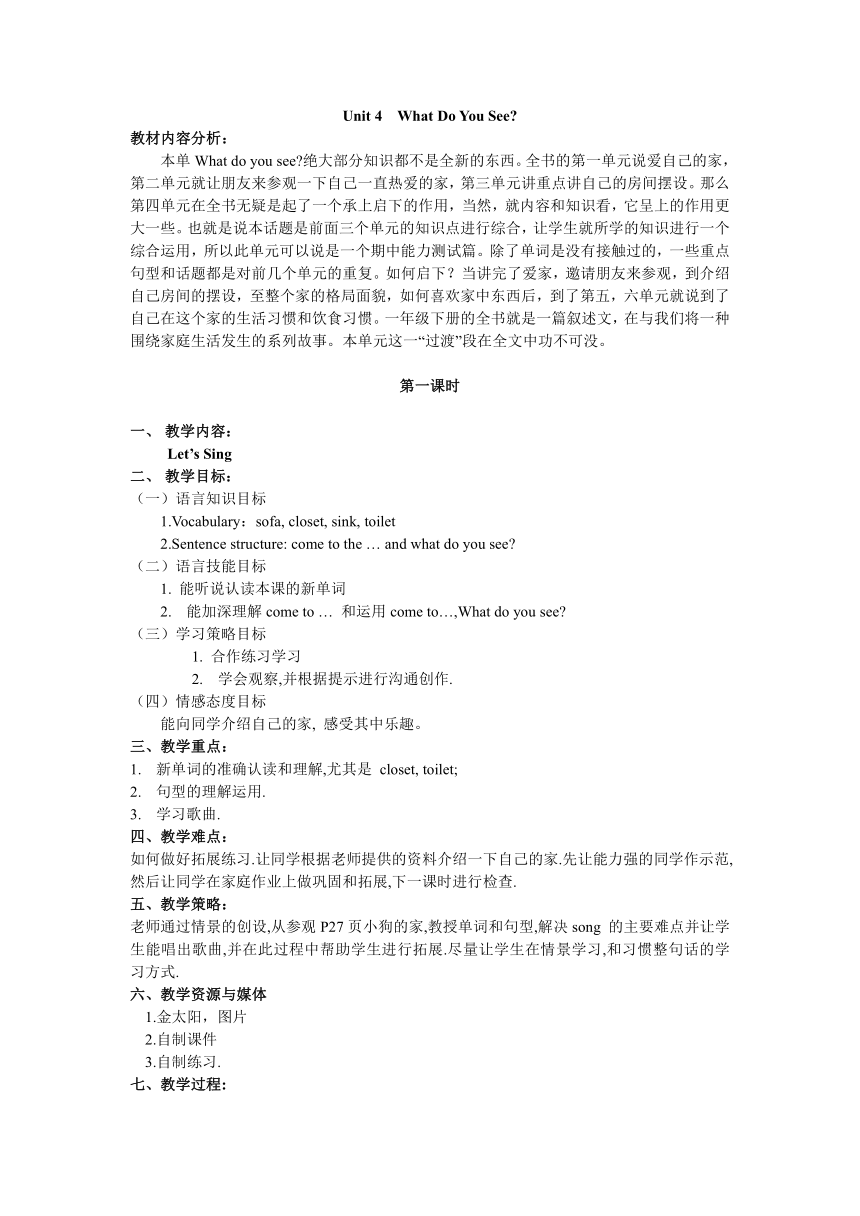
|
|
| 格式 | zip | ||
| 文件大小 | 21.1KB | ||
| 资源类型 | 教案 | ||
| 版本资源 | 教科版(广州) | ||
| 科目 | 英语 | ||
| 更新时间 | 2018-09-07 15:03:54 | ||
图片预览

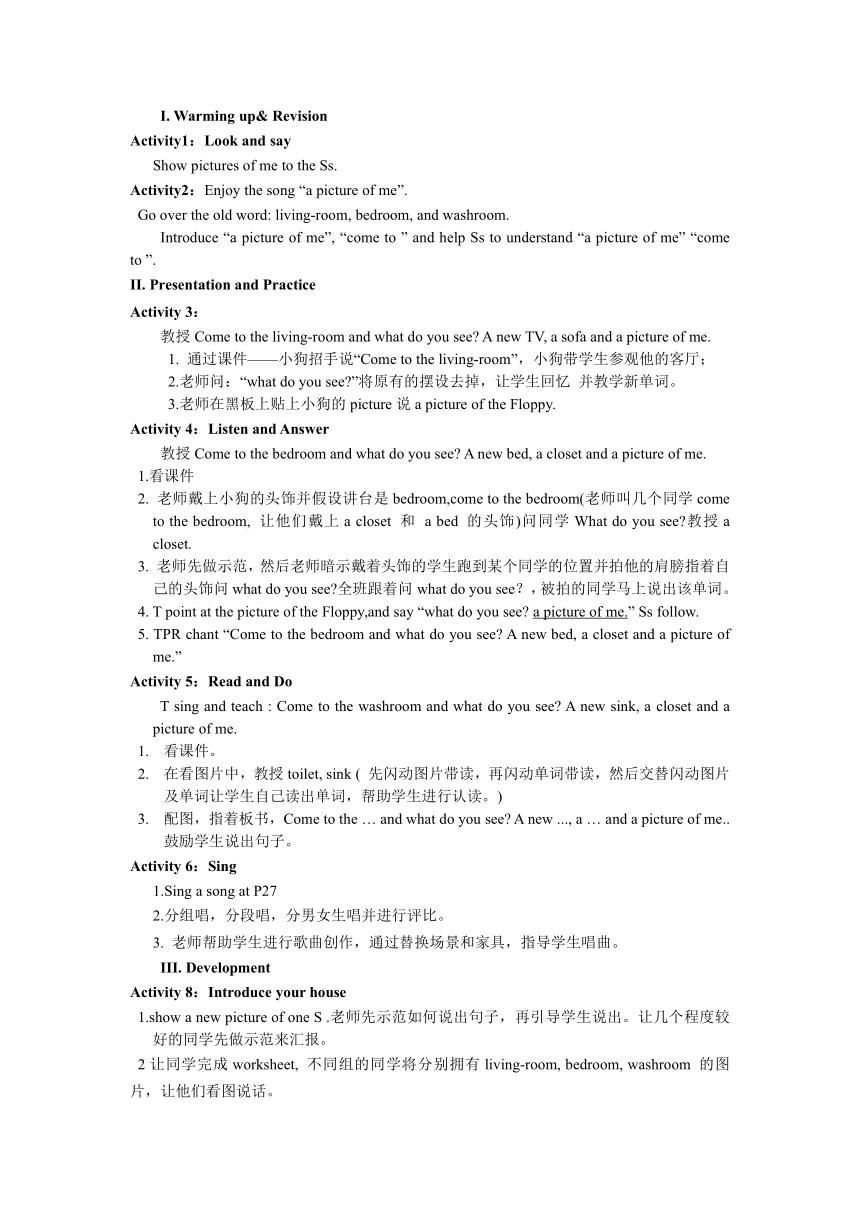
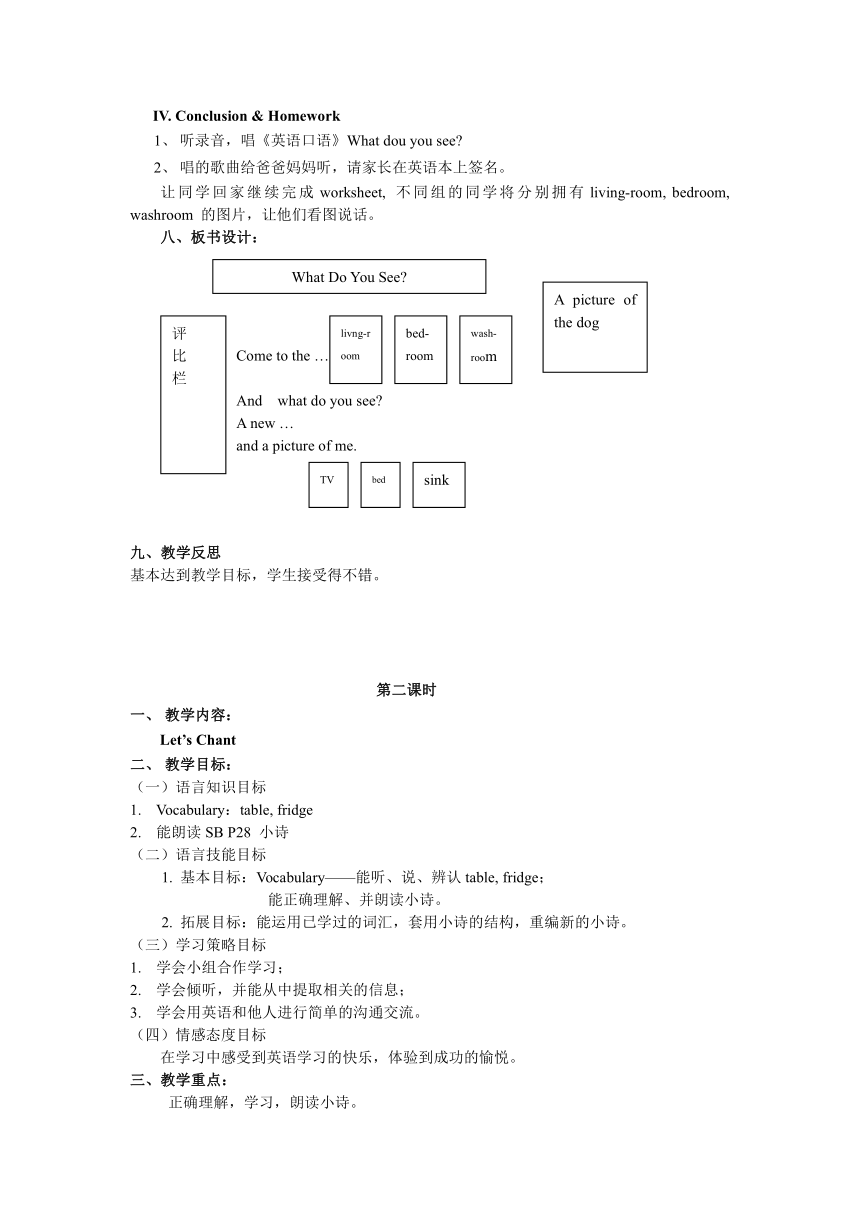
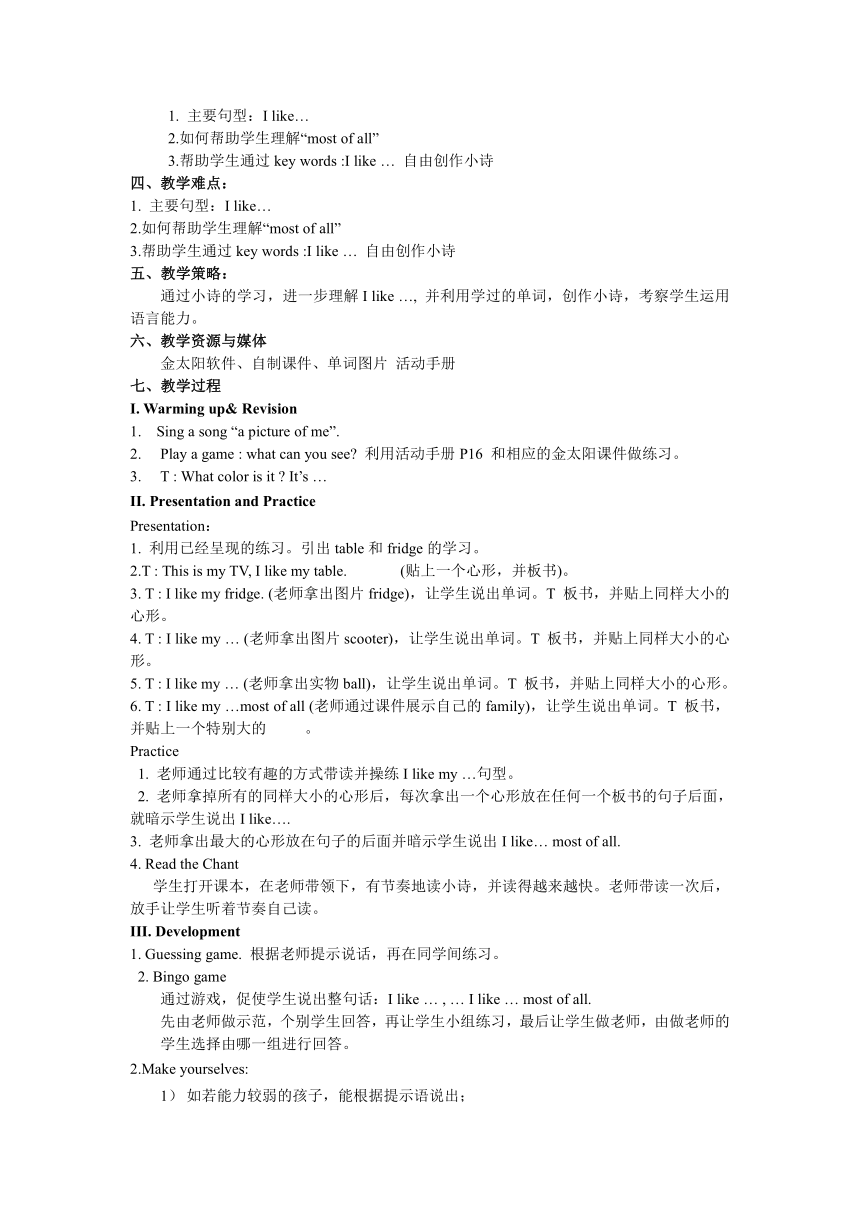
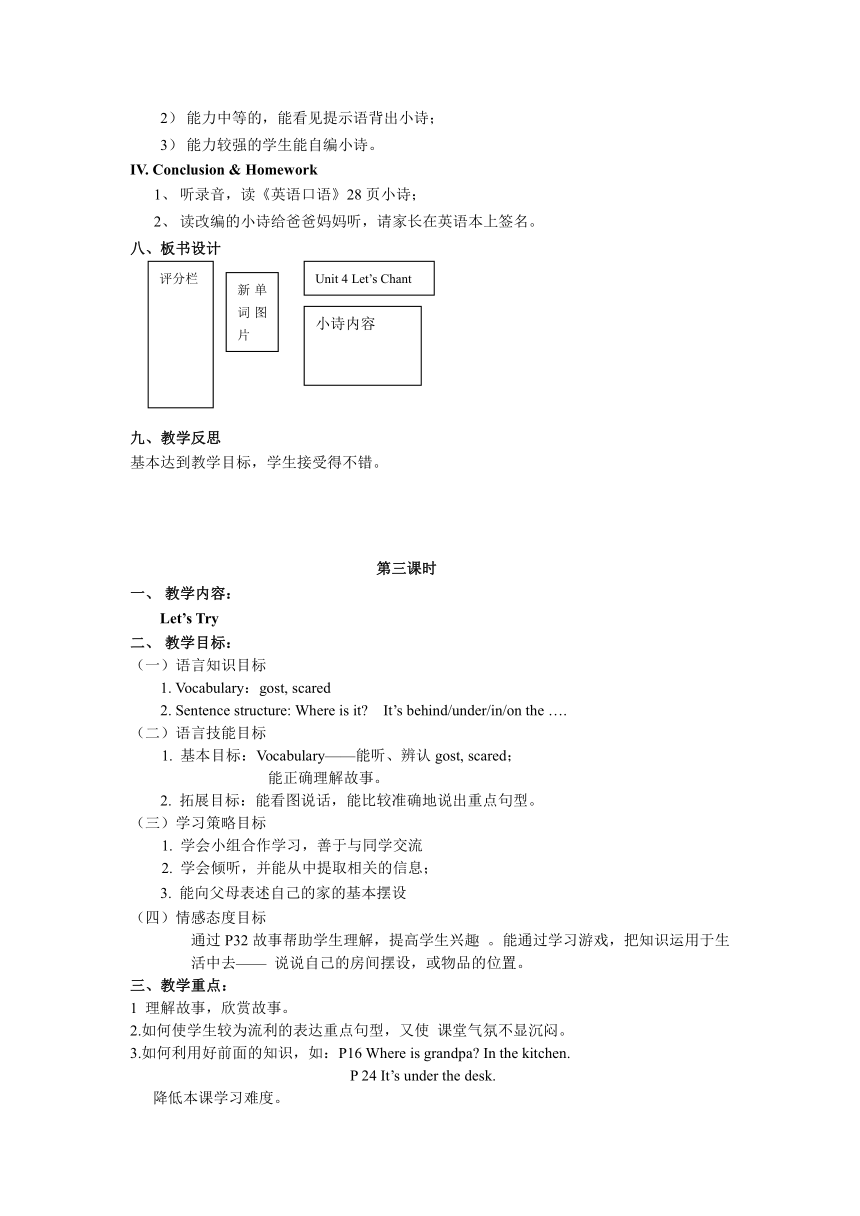
文档简介
Unit 4 What Do You See?
教材内容分析:
本单What do you see?绝大部分知识都不是全新的东西。全书的第一单元说爱自己的家,第二单元就让朋友来参观一下自己一直热爱的家,第三单元讲重点讲自己的房间摆设。那么第四单元在全书无疑是起了一个承上启下的作用,当然,就内容和知识看,它呈上的作用更大一些。也就是说本话题是前面三个单元的知识点进行综合,让学生就所学的知识进行一个综合运用,所以此单元可以说是一个期中能力测试篇。除了单词是没有接触过的,一些重点句型和话题都是对前几个单元的重复。如何启下?当讲完了爱家,邀请朋友来参观,到介绍自己房间的摆设,至整个家的格局面貌,如何喜欢家中东西后,到了第五,六单元就说到了自己在这个家的生活习惯和饮食习惯。一年级下册的全书就是一篇叙述文,在与我们将一种围绕家庭生活发生的系列故事。本单元这一“过渡”段在全文中功不可没。
第一课时
教学内容:
Let’s Sing
教学目标:
(一)语言知识目标
1.Vocabulary:sofa, closet, sink, toilet
2.Sentence structure: come to the … and what do you see?
(二)语言技能目标
1. 能听说认读本课的新单词
能加深理解come to … 和运用come to…,What do you see?
(三)学习策略目标
1. 合作练习学习
学会观察,并根据提示进行沟通创作.
(四)情感态度目标
能向同学介绍自己的家, 感受其中乐趣。
三、教学重点:
新单词的准确认读和理解,尤其是 closet, toilet;
句型的理解运用.
学习歌曲.
四、教学难点:
如何做好拓展练习.让同学根据老师提供的资料介绍一下自己的家.先让能力强的同学作示范,然后让同学在家庭作业上做巩固和拓展,下一课时进行检查.
五、教学策略:
老师通过情景的创设,从参观P27页小狗的家,教授单词和句型,解决song 的主要难点并让学生能唱出歌曲,并在此过程中帮助学生进行拓展.尽量让学生在情景学习,和习惯整句话的学习方式.
六、教学资源与媒体
1.金太阳,图片
2.自制课件
3.自制练习.
七、教学过程:
I. Warming up& Revision
Activity1:Look and say
Show pictures of me to the Ss.
Activity2:Enjoy the song “a picture of me”.
Go over the old word: living-room, bedroom, and washroom.
Introduce “a picture of me”, “come to ” and help Ss to understand “a picture of me” “come to ”.
II. Presentation and Practice
Activity 3:
教授Come to the living-room and what do you see? A new TV, a sofa and a picture of me.
1. 通过课件——小狗招手说“Come to the living-room”,小狗带学生参观他的客厅;
2.老师问:“what do you see?”将原有的摆设去掉,让学生回忆 并教学新单词。
3.老师在黑板上贴上小狗的picture说a picture of the Floppy.
Activity 4:Listen and Answer
教授Come to the bedroom and what do you see? A new bed, a closet and a picture of me.
1.看课件
2. 老师戴上小狗的头饰并假设讲台是bedroom,come to the bedroom(老师叫几个同学come to the bedroom, 让他们戴上a closet 和 a bed 的头饰)问同学What do you see?教授a closet.
3. 老师先做示范,然后老师暗示戴着头饰的学生跑到某个同学的位置并拍他的肩膀指着自己的头饰问what do you see?全班跟着问what do you see?,被拍的同学马上说出该单词。
4. T point at the picture of the Floppy,and say “what do you see? a picture of me.” Ss follow.
5. TPR chant “Come to the bedroom and what do you see? A new bed, a closet and a picture of me.”
Activity 5:Read and Do
T sing and teach : Come to the washroom and what do you see? A new sink, a closet and a picture of me.
看课件。
在看图片中,教授toilet, sink ( 先闪动图片带读,再闪动单词带读,然后交替闪动图片及单词让学生自己读出单词,帮助学生进行认读。)
配图,指着板书,Come to the … and what do you see? A new ..., a … and a picture of me..鼓励学生说出句子。
Activity 6:Sing
1.Sing a song at P27
2.分组唱,分段唱,分男女生唱并进行评比。
3. 老师帮助学生进行歌曲创作,通过替换场景和家具,指导学生唱曲。
III. Development
Activity 8:Introduce your house
1.show a new picture of one S .老师先示范如何说出句子,再引导学生说出。让几个程度较好的同学先做示范来汇报。
2让同学完成worksheet, 不同组的同学将分别拥有living-room, bedroom, washroom 的图片,让他们看图说话。
IV. Conclusion & Homework
听录音,唱《英语口语》What dou you see?
唱的歌曲给爸爸妈妈听,请家长在英语本上签名。
让同学回家继续完成worksheet, 不同组的同学将分别拥有living-room, bedroom, washroom 的图片,让他们看图说话。
八、板书设计:
九、教学反思
基本达到教学目标,学生接受得不错。
第二课时
教学内容:
Let’s Chant
教学目标:
(一)语言知识目标
Vocabulary:table, fridge
能朗读SB P28 小诗
(二)语言技能目标
1. 基本目标:Vocabulary——能听、说、辨认table, fridge;
能正确理解、并朗读小诗。
2. 拓展目标:能运用已学过的词汇,套用小诗的结构,重编新的小诗。
(三)学习策略目标
学会小组合作学习;
学会倾听,并能从中提取相关的信息;
学会用英语和他人进行简单的沟通交流。
(四)情感态度目标
在学习中感受到英语学习的快乐,体验到成功的愉悦。
三、教学重点:
正确理解,学习,朗读小诗。
1. 主要句型:I like…
2.如何帮助学生理解“most of all”
3.帮助学生通过key words :I like … 自由创作小诗
四、教学难点:
1. 主要句型:I like…
2.如何帮助学生理解“most of all”
3.帮助学生通过key words :I like … 自由创作小诗
五、教学策略:
通过小诗的学习,进一步理解I like …, 并利用学过的单词,创作小诗,考察学生运用语言能力。
六、教学资源与媒体
金太阳软件、自制课件、单词图片 活动手册
七、教学过程
I. Warming up& Revision
1. Sing a song “a picture of me”.
2. Play a game : what can you see? 利用活动手册P16 和相应的金太阳课件做练习。
3. T : What color is it ? It’s …
II. Presentation and Practice
Presentation:
1. 利用已经呈现的练习。引出table和fridge的学习。
2.T : This is my TV, I like my table. (贴上一个心形,并板书)。
3. T : I like my fridge. (老师拿出图片fridge),让学生说出单词。T 板书,并贴上同样大小的心形。
4. T : I like my … (老师拿出图片scooter),让学生说出单词。T 板书,并贴上同样大小的心形。
5. T : I like my … (老师拿出实物ball),让学生说出单词。T 板书,并贴上同样大小的心形。
6. T : I like my …most of all (老师通过课件展示自己的family),让学生说出单词。T 板书,并贴上一个特别大的 。
Practice
1. 老师通过比较有趣的方式带读并操练I like my …句型。
2. 老师拿掉所有的同样大小的心形后,每次拿出一个心形放在任何一个板书的句子后面,就暗示学生说出I like….
3. 老师拿出最大的心形放在句子的后面并暗示学生说出I like… most of all.
4. Read the Chant
学生打开课本,在老师带领下,有节奏地读小诗,并读得越来越快。老师带读一次后,放手让学生听着节奏自己读。
III. Development
1. Guessing game. 根据老师提示说话,再在同学间练习。
2. Bingo game
通过游戏,促使学生说出整句话:I like … , … I like … most of all.
先由老师做示范,个别学生回答,再让学生小组练习,最后让学生做老师,由做老师的学生选择由哪一组进行回答。
2.Make yourselves:
如若能力较弱的孩子,能根据提示语说出;
能力中等的,能看见提示语背出小诗;
能力较强的学生能自编小诗。
IV. Conclusion & Homework
听录音,读《英语口语》28页小诗;
读改编的小诗给爸爸妈妈听,请家长在英语本上签名。
八、板书设计
九、教学反思
基本达到教学目标,学生接受得不错。
第三课时
教学内容:
Let’s Try
教学目标:
(一)语言知识目标
1. Vocabulary:gost, scared
2. Sentence structure: Where is it? It’s behind/under/in/on the ….
(二)语言技能目标
1. 基本目标:Vocabulary——能听、辨认gost, scared;
能正确理解故事。
2. 拓展目标:能看图说话,能比较准确地说出重点句型。
(三)学习策略目标
1. 学会小组合作学习,善于与同学交流
2. 学会倾听,并能从中提取相关的信息;
3. 能向父母表述自己的家的基本摆设
(四)情感态度目标
通过P32故事帮助学生理解,提高学生兴趣 。能通过学习游戏,把知识运用于生活中去—— 说说自己的房间摆设,或物品的位置。
三、教学重点:
1 理解故事,欣赏故事。
2.如何使学生较为流利的表达重点句型,又使 课堂气氛不显沉闷。
3.如何利用好前面的知识,如:P16 Where is grandpa? In the kitchen.
P 24 It’s under the desk.
降低本课学习难度。
四、教学难点:
1.故事欣赏
2.正确理解句型, 比较流利地进行问答。
五、教学策略:
通过故事的简单讲述欣赏,引导学生进一步掌握重点句型,通过活动,游戏使学生在对话交流中增长知识。
六、教学资源与媒体
金太阳软件、自制课件、单词图片
七、教学过程:
I. Warming up& Revision
Activity1:Look and Do
老师做手势,学生根据老师的手势说出相应的方位介词。
Activity2:Make a chant
展示课件,请学生看课件,读小诗。小诗是结合已学的知识,具体如下:
In, in, in, in the bag.
On, on, on, on the bed.
Under, under, under, under the chair.
Behind, behind, behind the desk.
II. Presentation and Practice
Activity3:
1. Show some pictures of Ss’ house which the teacher asked them to draw before the class.
2. Show a picture of Amy. T asks: “Where is Amy?” Ss: “It’s in /on /under/behind…”
Activity 4:Story Tme:
1.Amy is very naughty, she goes here, goes there. Look! What happen to her?
老师通过金太阳向学生将关于发生在Amy家的故事。呈现新单词ghost & scared.
Listen to the story again and try to answer the Qs.
Activity 5:Listen and understand
当Amy’s brother打开门跑出去时,一只小老鼠忽然跑进来了,Amy cannot sleep. Amy gets help from the dog,Floppy. Look! Floppy is helping Amy catching the mouse. But where is the mouse?
让学生看金太阳课件。
Oh, Floppy can not catch the mouse. You are (Ss) all cats, can you help him?
让学生尝试记住画面的出现顺序,帮助Floppy抓老鼠。
Activity 5:Read and Do
1. 引导学生打开书找出正确顺序,帮助老师将正确的顺序排列出来。
2. 在整理出顺序后,老师可以用制作好的小老鼠,让学生问:Where is it?
老师将小老鼠放在哪一句,就带读哪一句。
让学生问:Where is it? 老师将小老鼠放在哪一句,就让学生起立抢答,那组答得最好的就加分。
III. Development
Activity6:Funny thing
1. 拿出老师在课前让学生制作活页
小书。
2.老师问,个别学生根据老师的翻页提示回答。
3.让两个同学做示范进行问答。然后全班小组练习,再作汇报。
IV. Conclusion & Homework
用制作好的活页小书,回去告诉爸爸妈妈所学知识。
八、板书设计:
九、教学反思:
基本达到教学目标,学生接受得不错。
第四课时
教学内容:
Story Time
教学目标:
(一)语言知识目标
1. Vocabulary:turtle,spider, scary
2. 句型:I want a … It’s…
(二)语言技能目标
基本目标:能听、说、辨认、理解故事的大意。
2. 拓展目标:初步复述故事
(三)学习策略目标
学会倾听,并能从中提取相关的信息;
学会用英语复述故事
(四)情感态度目标
从有趣的故事中,知道蝴蝶是由毛毛虫变成的
教学重点、难点:
故事的学习和句型的运用
四、教学策略
1.指导学生发现单词拼读规律,尝试认读单词。
2.通过情景、游戏、小组合作和TPR等,激发学生的学习兴趣,为学生创设学习和运用语言的条件。
五、教学资源与媒体
金太阳软件、单词图片
六、教学过程
I. Warming up& Revision
Activity1:Sing the song:
Activity2:Read the chnat
II. Presentation and Practice
Activity 3:Tell the story
1)播放金太阳课件的故事内容
2)提出问题:
3)再播放故事,提醒学生仔细观察
4)展示学生的回答
Activity 4:Retell the story
老师利用课文的插图,根据板书,向学生讲故事。(注意身体语言的使用和表情)
Activity 5:Retell the story again
老师再讲故事,引导学生边听边跟讲,特别是那两个不断重复的句子。
Activity6:看书跟读
老师指字,引导学生用手指着字跟读,让学生学会看字。这一环节很重要,让学生初步感知单词,对学生养成阅读,特别是三年级认单词打基础
III.Development
Activity 7:Game:引导学生看书复述故事
师生合作,请个别四个表现棒的学生与老师一起分部分复述故事。
老师带着全班同学一起复述故事
老师放手让学生自己复述故事
鼓励学生小组戴头饰合作复述故事
IV. Conclusion & Homework
听故事的录音,跟讲故事
把故事讲给爸爸妈妈听
七、板书设计:
八、教学反思:
基本达到教学目标,学生接受得不错。
第五课时
一、教学内容:
Amy’s Garden
二、教学目标
(一)语言知识目标
能用英语说出想要的食物。
(二)语言技能目标
能用I want the…与同学交流。
(三)学习策略目标
通过歌曲、表演等学会自我评价。
(四)情感态度目标
能大声读出英语句子,有大胆开口的能力和自信心。
三、教学重点、难点
自我评价。
四、教学策略
通过自评、小组评等方式,让学生学会自我评价。
五、教具准备:
录音机、录音带、图片
六、教学过程
Ⅰ Warm-up
Sing a song.
Review.
Ⅱ New lessons
1、Guessing Game.
2、Chant.
3、Show your name tag, and introduce yourself.
4、Show the story in groups.
5、Summary.
Ⅲ Development
1.Evaluate in groups.
2.Summary then write down the stars.
3.Fill your forms.
Ⅳ Homework
Show your stars to your parents.
七、板书设计:
八、教学反思:
基本达到教学目标,学生接受得不错。
第六课时 练习与小测
教学内容:
AMY’S GARDEN
教学目标:
语言知识目标:
1.Choose from a set of things what Amy wants to do in the story.
2.Put in the thinking bubbles pictures of the right things according to the story.
3.Join the teacher in telling the story.
4.Dramatize the story if possible.
5.Remember what they learned in this unit.
Skills: Listening speaking imagination dramatizing
语言技能目标:
Vocabulary
Known: watch TV, do your homework, Play video games, eat, ice-cream
Structures
Known: Can I?-?
New: My homework is done
学习策略目标:
通过歌曲、表演等学会自我评价。
情感态度与价值观:
能大声地朗读出英语句子,有大胆开口的能力和自信心。
教学重点和难点:
自我评价
教学策略:
通过自评、小组评等方式,让学生学会自我评价。
教具学具准备:
PPT.
教学过程与学法指导:
导入新课:
向学生宣布这节课的主要目的:检查我们在这个单元的学习情况。具体操作是没完成一项内容就得到一个☆。
评价过程:
Activity 1:Warming up
1.Sing the song in this unit.
2.Say the chant in this unit.
3.Mime the activities in the "Let's Try" section.
4.In-group of three, play doctor, policeman, nurse and teacher.
Activity 2. Story Time
1.Ask the children in Chinese if it's true that they must do their homework first before watching TV or playing at home. Talk to them about what their mum or dad will say if they watch TV or play before they do their homework.
2.Ask the children what Amy's mother would say if Amy wants to play before she does her homework. Put what the children say in English, and get them to imitate Amy's mother and speak in a harsh voice.
3.Tell the children they will listen to a story about Amy. Get them to guess what will be happen in the story.
4.Tell the story for the first time using the puppets. Make sure you use the different voices, intonations and facial expression for Amy, her mom and her baby, e.g. Use a harsh voice for the mother when she is speaking to Amy and use a soft voice for her when she's speaking to the baby.
5.Put up the pictures of Amy doing different things on the blackboard. Tell the children you are going to tell the story again and that you want them to choose the things Amy wants to do. Tell the story and ask the children to make the choice.
6.Tell the story again, inviting the children to join you. You may need to use a picture of a TV, a video game and an ice-cream to help the children remember the sequence.
7.Assign different roles for you and the children .Repeat the story together. Give the children the easier part at first.
8.The children practise acting the story in threes. You walk around the classroom and find the groups doing well. Ask them to act out the story for the whole class.
9.Invite the children to say what they learn from the story. This can be done in Chinese.
Activity 3: What did I learn?
1.Get the children to remember what they can say in English after this unit. Put on the corresponding cards on the blackboard.
2.Tell them to open their books on page 33, and get them to underline the pictures they can say in English. Discuss with them what they can do if there are things they don't know yet.
Homework:
Get the children to evaluate their work in this unit and tick one of the pictures at the bottom of page 33.
小结评价结果:
小组内进行互评,组内被推选表现最好的同学可得到一个☆。
让学生填写课本P34上的评价:I have______☆ for Unit4. 及自评自己在本单元内的表现属于OK/Good/Great,并在相应的单词上打上√。
选出获得☆最多的同学,老师进行适当的奖励。
七、 板书设计:
AMY’S GARDEN & Self-assesment
AMY’S GARDEN
Self-assesment
Task 1 song
Task 2 chant
Task 3 story time
P34
I have______☆ for Unit4.
OK/Good/Great
八、 教学反思:
基本达到教学目标,学生接受得不错。
教材内容分析:
本单What do you see?绝大部分知识都不是全新的东西。全书的第一单元说爱自己的家,第二单元就让朋友来参观一下自己一直热爱的家,第三单元讲重点讲自己的房间摆设。那么第四单元在全书无疑是起了一个承上启下的作用,当然,就内容和知识看,它呈上的作用更大一些。也就是说本话题是前面三个单元的知识点进行综合,让学生就所学的知识进行一个综合运用,所以此单元可以说是一个期中能力测试篇。除了单词是没有接触过的,一些重点句型和话题都是对前几个单元的重复。如何启下?当讲完了爱家,邀请朋友来参观,到介绍自己房间的摆设,至整个家的格局面貌,如何喜欢家中东西后,到了第五,六单元就说到了自己在这个家的生活习惯和饮食习惯。一年级下册的全书就是一篇叙述文,在与我们将一种围绕家庭生活发生的系列故事。本单元这一“过渡”段在全文中功不可没。
第一课时
教学内容:
Let’s Sing
教学目标:
(一)语言知识目标
1.Vocabulary:sofa, closet, sink, toilet
2.Sentence structure: come to the … and what do you see?
(二)语言技能目标
1. 能听说认读本课的新单词
能加深理解come to … 和运用come to…,What do you see?
(三)学习策略目标
1. 合作练习学习
学会观察,并根据提示进行沟通创作.
(四)情感态度目标
能向同学介绍自己的家, 感受其中乐趣。
三、教学重点:
新单词的准确认读和理解,尤其是 closet, toilet;
句型的理解运用.
学习歌曲.
四、教学难点:
如何做好拓展练习.让同学根据老师提供的资料介绍一下自己的家.先让能力强的同学作示范,然后让同学在家庭作业上做巩固和拓展,下一课时进行检查.
五、教学策略:
老师通过情景的创设,从参观P27页小狗的家,教授单词和句型,解决song 的主要难点并让学生能唱出歌曲,并在此过程中帮助学生进行拓展.尽量让学生在情景学习,和习惯整句话的学习方式.
六、教学资源与媒体
1.金太阳,图片
2.自制课件
3.自制练习.
七、教学过程:
I. Warming up& Revision
Activity1:Look and say
Show pictures of me to the Ss.
Activity2:Enjoy the song “a picture of me”.
Go over the old word: living-room, bedroom, and washroom.
Introduce “a picture of me”, “come to ” and help Ss to understand “a picture of me” “come to ”.
II. Presentation and Practice
Activity 3:
教授Come to the living-room and what do you see? A new TV, a sofa and a picture of me.
1. 通过课件——小狗招手说“Come to the living-room”,小狗带学生参观他的客厅;
2.老师问:“what do you see?”将原有的摆设去掉,让学生回忆 并教学新单词。
3.老师在黑板上贴上小狗的picture说a picture of the Floppy.
Activity 4:Listen and Answer
教授Come to the bedroom and what do you see? A new bed, a closet and a picture of me.
1.看课件
2. 老师戴上小狗的头饰并假设讲台是bedroom,come to the bedroom(老师叫几个同学come to the bedroom, 让他们戴上a closet 和 a bed 的头饰)问同学What do you see?教授a closet.
3. 老师先做示范,然后老师暗示戴着头饰的学生跑到某个同学的位置并拍他的肩膀指着自己的头饰问what do you see?全班跟着问what do you see?,被拍的同学马上说出该单词。
4. T point at the picture of the Floppy,and say “what do you see? a picture of me.” Ss follow.
5. TPR chant “Come to the bedroom and what do you see? A new bed, a closet and a picture of me.”
Activity 5:Read and Do
T sing and teach : Come to the washroom and what do you see? A new sink, a closet and a picture of me.
看课件。
在看图片中,教授toilet, sink ( 先闪动图片带读,再闪动单词带读,然后交替闪动图片及单词让学生自己读出单词,帮助学生进行认读。)
配图,指着板书,Come to the … and what do you see? A new ..., a … and a picture of me..鼓励学生说出句子。
Activity 6:Sing
1.Sing a song at P27
2.分组唱,分段唱,分男女生唱并进行评比。
3. 老师帮助学生进行歌曲创作,通过替换场景和家具,指导学生唱曲。
III. Development
Activity 8:Introduce your house
1.show a new picture of one S .老师先示范如何说出句子,再引导学生说出。让几个程度较好的同学先做示范来汇报。
2让同学完成worksheet, 不同组的同学将分别拥有living-room, bedroom, washroom 的图片,让他们看图说话。
IV. Conclusion & Homework
听录音,唱《英语口语》What dou you see?
唱的歌曲给爸爸妈妈听,请家长在英语本上签名。
让同学回家继续完成worksheet, 不同组的同学将分别拥有living-room, bedroom, washroom 的图片,让他们看图说话。
八、板书设计:
九、教学反思
基本达到教学目标,学生接受得不错。
第二课时
教学内容:
Let’s Chant
教学目标:
(一)语言知识目标
Vocabulary:table, fridge
能朗读SB P28 小诗
(二)语言技能目标
1. 基本目标:Vocabulary——能听、说、辨认table, fridge;
能正确理解、并朗读小诗。
2. 拓展目标:能运用已学过的词汇,套用小诗的结构,重编新的小诗。
(三)学习策略目标
学会小组合作学习;
学会倾听,并能从中提取相关的信息;
学会用英语和他人进行简单的沟通交流。
(四)情感态度目标
在学习中感受到英语学习的快乐,体验到成功的愉悦。
三、教学重点:
正确理解,学习,朗读小诗。
1. 主要句型:I like…
2.如何帮助学生理解“most of all”
3.帮助学生通过key words :I like … 自由创作小诗
四、教学难点:
1. 主要句型:I like…
2.如何帮助学生理解“most of all”
3.帮助学生通过key words :I like … 自由创作小诗
五、教学策略:
通过小诗的学习,进一步理解I like …, 并利用学过的单词,创作小诗,考察学生运用语言能力。
六、教学资源与媒体
金太阳软件、自制课件、单词图片 活动手册
七、教学过程
I. Warming up& Revision
1. Sing a song “a picture of me”.
2. Play a game : what can you see? 利用活动手册P16 和相应的金太阳课件做练习。
3. T : What color is it ? It’s …
II. Presentation and Practice
Presentation:
1. 利用已经呈现的练习。引出table和fridge的学习。
2.T : This is my TV, I like my table. (贴上一个心形,并板书)。
3. T : I like my fridge. (老师拿出图片fridge),让学生说出单词。T 板书,并贴上同样大小的心形。
4. T : I like my … (老师拿出图片scooter),让学生说出单词。T 板书,并贴上同样大小的心形。
5. T : I like my … (老师拿出实物ball),让学生说出单词。T 板书,并贴上同样大小的心形。
6. T : I like my …most of all (老师通过课件展示自己的family),让学生说出单词。T 板书,并贴上一个特别大的 。
Practice
1. 老师通过比较有趣的方式带读并操练I like my …句型。
2. 老师拿掉所有的同样大小的心形后,每次拿出一个心形放在任何一个板书的句子后面,就暗示学生说出I like….
3. 老师拿出最大的心形放在句子的后面并暗示学生说出I like… most of all.
4. Read the Chant
学生打开课本,在老师带领下,有节奏地读小诗,并读得越来越快。老师带读一次后,放手让学生听着节奏自己读。
III. Development
1. Guessing game. 根据老师提示说话,再在同学间练习。
2. Bingo game
通过游戏,促使学生说出整句话:I like … , … I like … most of all.
先由老师做示范,个别学生回答,再让学生小组练习,最后让学生做老师,由做老师的学生选择由哪一组进行回答。
2.Make yourselves:
如若能力较弱的孩子,能根据提示语说出;
能力中等的,能看见提示语背出小诗;
能力较强的学生能自编小诗。
IV. Conclusion & Homework
听录音,读《英语口语》28页小诗;
读改编的小诗给爸爸妈妈听,请家长在英语本上签名。
八、板书设计
九、教学反思
基本达到教学目标,学生接受得不错。
第三课时
教学内容:
Let’s Try
教学目标:
(一)语言知识目标
1. Vocabulary:gost, scared
2. Sentence structure: Where is it? It’s behind/under/in/on the ….
(二)语言技能目标
1. 基本目标:Vocabulary——能听、辨认gost, scared;
能正确理解故事。
2. 拓展目标:能看图说话,能比较准确地说出重点句型。
(三)学习策略目标
1. 学会小组合作学习,善于与同学交流
2. 学会倾听,并能从中提取相关的信息;
3. 能向父母表述自己的家的基本摆设
(四)情感态度目标
通过P32故事帮助学生理解,提高学生兴趣 。能通过学习游戏,把知识运用于生活中去—— 说说自己的房间摆设,或物品的位置。
三、教学重点:
1 理解故事,欣赏故事。
2.如何使学生较为流利的表达重点句型,又使 课堂气氛不显沉闷。
3.如何利用好前面的知识,如:P16 Where is grandpa? In the kitchen.
P 24 It’s under the desk.
降低本课学习难度。
四、教学难点:
1.故事欣赏
2.正确理解句型, 比较流利地进行问答。
五、教学策略:
通过故事的简单讲述欣赏,引导学生进一步掌握重点句型,通过活动,游戏使学生在对话交流中增长知识。
六、教学资源与媒体
金太阳软件、自制课件、单词图片
七、教学过程:
I. Warming up& Revision
Activity1:Look and Do
老师做手势,学生根据老师的手势说出相应的方位介词。
Activity2:Make a chant
展示课件,请学生看课件,读小诗。小诗是结合已学的知识,具体如下:
In, in, in, in the bag.
On, on, on, on the bed.
Under, under, under, under the chair.
Behind, behind, behind the desk.
II. Presentation and Practice
Activity3:
1. Show some pictures of Ss’ house which the teacher asked them to draw before the class.
2. Show a picture of Amy. T asks: “Where is Amy?” Ss: “It’s in /on /under/behind…”
Activity 4:Story Tme:
1.Amy is very naughty, she goes here, goes there. Look! What happen to her?
老师通过金太阳向学生将关于发生在Amy家的故事。呈现新单词ghost & scared.
Listen to the story again and try to answer the Qs.
Activity 5:Listen and understand
当Amy’s brother打开门跑出去时,一只小老鼠忽然跑进来了,Amy cannot sleep. Amy gets help from the dog,Floppy. Look! Floppy is helping Amy catching the mouse. But where is the mouse?
让学生看金太阳课件。
Oh, Floppy can not catch the mouse. You are (Ss) all cats, can you help him?
让学生尝试记住画面的出现顺序,帮助Floppy抓老鼠。
Activity 5:Read and Do
1. 引导学生打开书找出正确顺序,帮助老师将正确的顺序排列出来。
2. 在整理出顺序后,老师可以用制作好的小老鼠,让学生问:Where is it?
老师将小老鼠放在哪一句,就带读哪一句。
让学生问:Where is it? 老师将小老鼠放在哪一句,就让学生起立抢答,那组答得最好的就加分。
III. Development
Activity6:Funny thing
1. 拿出老师在课前让学生制作活页
小书。
2.老师问,个别学生根据老师的翻页提示回答。
3.让两个同学做示范进行问答。然后全班小组练习,再作汇报。
IV. Conclusion & Homework
用制作好的活页小书,回去告诉爸爸妈妈所学知识。
八、板书设计:
九、教学反思:
基本达到教学目标,学生接受得不错。
第四课时
教学内容:
Story Time
教学目标:
(一)语言知识目标
1. Vocabulary:turtle,spider, scary
2. 句型:I want a … It’s…
(二)语言技能目标
基本目标:能听、说、辨认、理解故事的大意。
2. 拓展目标:初步复述故事
(三)学习策略目标
学会倾听,并能从中提取相关的信息;
学会用英语复述故事
(四)情感态度目标
从有趣的故事中,知道蝴蝶是由毛毛虫变成的
教学重点、难点:
故事的学习和句型的运用
四、教学策略
1.指导学生发现单词拼读规律,尝试认读单词。
2.通过情景、游戏、小组合作和TPR等,激发学生的学习兴趣,为学生创设学习和运用语言的条件。
五、教学资源与媒体
金太阳软件、单词图片
六、教学过程
I. Warming up& Revision
Activity1:Sing the song:
Activity2:Read the chnat
II. Presentation and Practice
Activity 3:Tell the story
1)播放金太阳课件的故事内容
2)提出问题:
3)再播放故事,提醒学生仔细观察
4)展示学生的回答
Activity 4:Retell the story
老师利用课文的插图,根据板书,向学生讲故事。(注意身体语言的使用和表情)
Activity 5:Retell the story again
老师再讲故事,引导学生边听边跟讲,特别是那两个不断重复的句子。
Activity6:看书跟读
老师指字,引导学生用手指着字跟读,让学生学会看字。这一环节很重要,让学生初步感知单词,对学生养成阅读,特别是三年级认单词打基础
III.Development
Activity 7:Game:引导学生看书复述故事
师生合作,请个别四个表现棒的学生与老师一起分部分复述故事。
老师带着全班同学一起复述故事
老师放手让学生自己复述故事
鼓励学生小组戴头饰合作复述故事
IV. Conclusion & Homework
听故事的录音,跟讲故事
把故事讲给爸爸妈妈听
七、板书设计:
八、教学反思:
基本达到教学目标,学生接受得不错。
第五课时
一、教学内容:
Amy’s Garden
二、教学目标
(一)语言知识目标
能用英语说出想要的食物。
(二)语言技能目标
能用I want the…与同学交流。
(三)学习策略目标
通过歌曲、表演等学会自我评价。
(四)情感态度目标
能大声读出英语句子,有大胆开口的能力和自信心。
三、教学重点、难点
自我评价。
四、教学策略
通过自评、小组评等方式,让学生学会自我评价。
五、教具准备:
录音机、录音带、图片
六、教学过程
Ⅰ Warm-up
Sing a song.
Review.
Ⅱ New lessons
1、Guessing Game.
2、Chant.
3、Show your name tag, and introduce yourself.
4、Show the story in groups.
5、Summary.
Ⅲ Development
1.Evaluate in groups.
2.Summary then write down the stars.
3.Fill your forms.
Ⅳ Homework
Show your stars to your parents.
七、板书设计:
八、教学反思:
基本达到教学目标,学生接受得不错。
第六课时 练习与小测
教学内容:
AMY’S GARDEN
教学目标:
语言知识目标:
1.Choose from a set of things what Amy wants to do in the story.
2.Put in the thinking bubbles pictures of the right things according to the story.
3.Join the teacher in telling the story.
4.Dramatize the story if possible.
5.Remember what they learned in this unit.
Skills: Listening speaking imagination dramatizing
语言技能目标:
Vocabulary
Known: watch TV, do your homework, Play video games, eat, ice-cream
Structures
Known: Can I?-?
New: My homework is done
学习策略目标:
通过歌曲、表演等学会自我评价。
情感态度与价值观:
能大声地朗读出英语句子,有大胆开口的能力和自信心。
教学重点和难点:
自我评价
教学策略:
通过自评、小组评等方式,让学生学会自我评价。
教具学具准备:
PPT.
教学过程与学法指导:
导入新课:
向学生宣布这节课的主要目的:检查我们在这个单元的学习情况。具体操作是没完成一项内容就得到一个☆。
评价过程:
Activity 1:Warming up
1.Sing the song in this unit.
2.Say the chant in this unit.
3.Mime the activities in the "Let's Try" section.
4.In-group of three, play doctor, policeman, nurse and teacher.
Activity 2. Story Time
1.Ask the children in Chinese if it's true that they must do their homework first before watching TV or playing at home. Talk to them about what their mum or dad will say if they watch TV or play before they do their homework.
2.Ask the children what Amy's mother would say if Amy wants to play before she does her homework. Put what the children say in English, and get them to imitate Amy's mother and speak in a harsh voice.
3.Tell the children they will listen to a story about Amy. Get them to guess what will be happen in the story.
4.Tell the story for the first time using the puppets. Make sure you use the different voices, intonations and facial expression for Amy, her mom and her baby, e.g. Use a harsh voice for the mother when she is speaking to Amy and use a soft voice for her when she's speaking to the baby.
5.Put up the pictures of Amy doing different things on the blackboard. Tell the children you are going to tell the story again and that you want them to choose the things Amy wants to do. Tell the story and ask the children to make the choice.
6.Tell the story again, inviting the children to join you. You may need to use a picture of a TV, a video game and an ice-cream to help the children remember the sequence.
7.Assign different roles for you and the children .Repeat the story together. Give the children the easier part at first.
8.The children practise acting the story in threes. You walk around the classroom and find the groups doing well. Ask them to act out the story for the whole class.
9.Invite the children to say what they learn from the story. This can be done in Chinese.
Activity 3: What did I learn?
1.Get the children to remember what they can say in English after this unit. Put on the corresponding cards on the blackboard.
2.Tell them to open their books on page 33, and get them to underline the pictures they can say in English. Discuss with them what they can do if there are things they don't know yet.
Homework:
Get the children to evaluate their work in this unit and tick one of the pictures at the bottom of page 33.
小结评价结果:
小组内进行互评,组内被推选表现最好的同学可得到一个☆。
让学生填写课本P34上的评价:I have______☆ for Unit4. 及自评自己在本单元内的表现属于OK/Good/Great,并在相应的单词上打上√。
选出获得☆最多的同学,老师进行适当的奖励。
七、 板书设计:
AMY’S GARDEN & Self-assesment
AMY’S GARDEN
Self-assesment
Task 1 song
Task 2 chant
Task 3 story time
P34
I have______☆ for Unit4.
OK/Good/Great
八、 教学反思:
基本达到教学目标,学生接受得不错。
